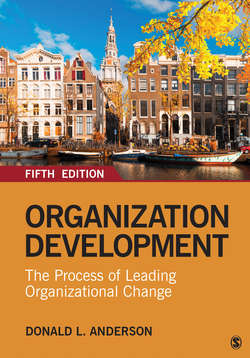Читать книгу Organization Development - Donald L. Anderson - Страница 41
На сайте Литреса книга снята с продажи.
Change Management, Strategic Change, and Reengineering
ОглавлениеA sixth strand of organization development practice grew rapidly in the 1980s and 1990s. It went by several labels, such as strategic change and change management, and manifested in part in the practice of transformational change, or reengineering. OD practitioners began to connect their work to larger, organizationwide goals, with a firm foundation in theories and research in organizational change. Change has always been a central theme in OD, but it was in the 1980s that academic research and practice increasingly began to adopt the language of strategic change. It was at this time that practitioners began to realize that change was at the center of organizations. It was more frequently a part of conversations among executives and employees, becoming a hallmark of how organizations function and the rationale for many decisions. Writers and practitioners alike noticed that the best organizational strategy would make little difference unless it was implemented effectively. The ability to effectively adopt change became the difference between successful and mediocre organizations.
The use of OD theories and concepts made sense to those involved in strategic change efforts. Not only do organizations need to focus attention on such external issues as market conditions, customer needs, competitive positioning, and financial concerns, they also must manage change internally. Traditionally, strategic planning has a history in economics and finance, and it is focused on the organization and its environment. OD has been more focused on people with a history in the social sciences. In the 1990s and 2000s, practitioners increasingly saw that the two fields have much to offer one another. When a corporation must shift its strategy to better position itself competitively, the change required is both external and internal, as employees must be informed, involved, and motivated to help make this shift (Worley, Hitchin, & Ross, 1996). Even writers who direct their work to business executives and who focus on the economics of strategy also often include sections on communication, education, goals, objectives, and rewards, admitting that even the best strategy is of little use unless executed properly, and that the alignment of employees and strategy is critical (e.g., R. S. Kaplan & Norton, 2001). Many writers see that the field of OD offers the field of strategic planning the ability to address the human and personal aspects of organizational change, while a focus on strategy requires OD practitioners to better understand the business, internally and externally, and the context for change.
The change management movement encouraged practitioners to address the organization’s vision, mission, goals, and strategy. Practitioners connected this vision and goals to the organization’s social, political, technological, and cultural elements to ensure consistency, remove barriers, and involve multiple levels of the organization. This has had a significant influence on how OD is done today, as it has required that OD practitioners understand the environment and its challenges to the organization (whether it be a business, educational system, nonprofit organization, or government entity). Models and theories of organizational change are such a foundation of organization development work and such an important background for the OD practitioner that we devote our entire attention to them in Chapter 4, and we discuss the reengineering movement more specifically in Chapter 12.
